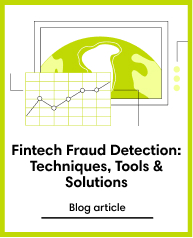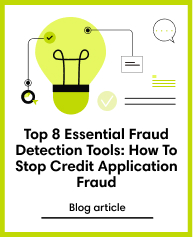Fraud
Dec 1, 2022
Insights from a former risk officer: Part 2 on introducing fraud detection
Find out how to identify, assess, and mitigate fraud risks with bespoke machine learning models to mitigate fraud costs in the best way.

Customer Success Manager
Subscribe to our newsletter

In the wake of the pandemic, digital transformation evolved by leaps and bounds. More than 50% of consumers now interact with their bank via mobile apps or websites at least once a week compared to 32% two years ago. Though increasing exposure to this digital world has many benefits, it also poses a big risk called incremental fraud, which affects both institutions and users.
By definition, fraud is a crime committed to illegally gain one's own financial gain. As technology advances, fraudsters and fraudulent customers become more professional and ingenuous at gaming financial institutions’ systems and preventive measures. As a follow-up to Part 1 on fraud detection, this article will explore the impact of fraud and the cost of not having advanced risk and fraud management processes and technologies.
The cost of fraud
The number of fraud cases has increased at an unprecedented rate over the past few years. As transactions grow, so do fraud and its cost, which impacts both users and institutions. The impact of fraud can vary depending on the volume of transactions, the magnitude of the scam, the uniqueness of the fraud, and the ingenuity of the fraudster. Inherent to each fraud case is a cost that translates to large amounts of money companies must bear as a loss. What's worse, this trend is only growing.
LexisNexis’ True Cost of Fraud Study illustrates how fraud continues to rise, up to 22.4% since early 2020. Fraud also increased by 57% for U.S. investment firms and 64% for U.S. credit lenders.
Fraud costs and attack volumes remain significantly higher than before the COVID-19 pandemic, particularly with application fraud through direct-to-consumer transactions. The cost of fraud is highest among U.S. banks, with every $1 of fraud loss costs $4.36, and for mortgage firms, with every $1 of fraud loss costs $4.20.
Global losses from payment fraud tripled from $9.84 billion in 2011 to $32.39 in 2020. Similarly, payment fraud is expected to continue to increase, with a projected cost of $40.62 billion in 2022. Fraud Risk Management surveys highlight that organisations lose up to 7% of their annual turnover due to fraud, with only a small percentage recovered.
Fraud in a mobile-centric world
Digitalisation has been a catalyser for fraud attempts. More consumers engaged in digital transactions during the pandemic, increasing smartphone usage and reliance. In some cases, the volume of mobile transactions matched or exceeded that of online transactions. This increase in smartphone usage led to a surge of fraudsters targeting mobile, including malicious bot attacks. Mobile fraud now accounts for approximately one-third of fraud costs. Fraud continues to target mobile channel transactions, with 95% of financial service firms and 96% of lenders saying fraud targeting mobile has increased.
In the case of the United States, fraud costs attributed to the mobile channel have increased dramatically from previous years. For US retail, mobile fraud increased by 19% and now accounts for 27% of the total cost of fraud. For US commerce, mobile fraud has increased significantly by 34%, rising from 8% in 2020 to 39% in 2021. As a result, mobile transaction fraud now accounts for 29% of the total cost of fraud compared to 20% in 2020. Furthermore, the average volume of monthly attacks increased to 2,320 in 2021 from 1,977 monthly attacks in 2020. In total, that's up to 2,000 attacks on banks every month and about 24,000 every year.
Within industries, it is not surprising that online banking fraud accounted for the largest proportion of US fraud in 2021 and 2020. Interestingly, the contribution of in-person fraud to total fraud also saw a dramatic increase from 21% to 29%.
The impact of fraud
Financial losses are not the only impact of fraud. Until now, we have discussed fraud's monetary costs. However, fraud loss is part of the provisioning calculation, which will be part of the cost of the application, and therefore impacts businesses’ P&L (Profit and Loss) calculations. Unfortunately, every business needs to account for this cost.
Other impacts of fraud include on people, industries, entities, services and the environment:
- Human Impact: Fraud can be a traumatic experience that often causes a real and irreversible impact. People who rely on government services are usually the most affected, and fraud only increases the already existing disadvantages, vulnerabilities and inequalities for these people.
- Government outcomes impact: With fraud, money and services are diverted away from those who need them. Because of this, fraud can undermine the government's ability to deliver quality services.
- Reputational impact: Poorly handled fraud can erode trust in the government and industry and ultimately lead to a loss of brand and economic reputation.
- Industry impact: Fraud can result in distorted markets where fraudsters obtain a competitive advantage and drive out legitimate businesses. As a result, charities and community services that help those affected by fraud may be burdened with greater burdens.
- Environmental impact: Fraud can drive environmental damage through pollution and damaged ecosystems and biodiversity. It can also incur significant clean-up costs.
- Security impact: Fraud can undermine national defence and security through damage to international standing and a loss in international credibility. It can even potentially fund organised crime groups and terrorism.
A proactive approach to fraud management
All companies are affected by fraud, regardless of their size, industry, or location. Fraud affects multinational companies the most, but smaller companies also suffer huge losses and are less likely to be able to absorb the damage. Despite the serious risks fraud poses to businesses, many organisations still lack systems and procedures to prevent it. Fortunately, there are solutions for early detection.
Companies must invest time, money, and resources to identify, assess, and mitigate fraud risks to combat the cost of fraud. It is imperative to take a proactive rather than reactive approach to fraudulent attacks or events to prevent threats. It is essential to pay attention to trends and behaviour to prevent fraud and stop the problem before it occurs.
"Simple, secure and enhanced verification, security and user authentication is essential for preventing scams and fighting crime. Also, leading financial institutions leverage AI and Machine Learning to process large amounts of information, creating rules to detect fraudulent actions and combat fraudsters."
By Michele Tucci, MD Americas and Chief Strategy Officer of credolab.
As mentioned in Part 1, to develop an effective fraud detection strategy, it is necessary to have a clear roadmap, work hand-in-hand with data science teams and use cutting-edge technologies that can help predict user behaviour. It is crucial to target these areas to ensure the strategy is successful:
- People, strategy and governance
- Balance
- Assessment
- Prevention and detection
- Technology and analytics
Another important factor is managing and improving alarms or red flags to detect early attacks and system anomalies. Below are some red flags that can be used to identify fraud at the customer onboarding stage:

Furthermore, red flags may look different depending on the industry and financial product. For example, to detect loan fraud, banks must look out for the following:
- Multiple businesses under one person’s name
- No physical location or address of business
- A startup idea is not a running business
- Lack of references
- Inflated earnings
- Lack of financial audits
How can Credolab help detect and prevent fraud
Vetting and screening applications for loans and credit cards is a complicated, time-consuming, and expensive process. Fraud detection systems using new technologies minimise fraud investigation time by 70% and improve detection accuracy by 90%. Credolab, for example, leverages machine learning to process large data sets and create algorithms to find repetitive patterns between user behaviour and the likelihood of suspicious actions. Using a smartphone device ID and metadata makes it possible to reach a fraud score for each applicant in a secure, non-intrusive, frictionless, and real-time manner.
Credolab determines these fraud scores based on the below:
- A comprehensive database of devices and fraud evidence: In collaboration with TruValidate, a TransUnion solution, the fraud score algorithm is powered by the biggest network of devices and fraud reports in the world, with a base of over six billion unique consumer devices.
- Identification of device and account linkages: Credolab can identify suspicious devices from genuine ones and even the hidden connections between devices and accounts.
- More secure than the traditional approach: With a device metadata-led approach, it is possible to know the devices connected to the anonymous customer ID.
- Agile in response and adaptability in collaboration with TruValidate: The powerful and flexible business rules editor enables fraud analysts to react immediately to new threats.
- Real-time analysis and high predictability: Within seconds, the analysis is completed, and a credit score and fraud score are sent to the underwriter.
Credolab can turn these identified red flags into granular insights for customers. Some examples include an early fraud indicator, fraud score, IP mismatch, or flags for referral abuse, cashback abuse and loyalty points abuse.
One example is clients can combine the credolab scores, indicating a likelihood of fraud through a rating and using their internal checks to make an immediate decision based on certain criteria. Credolab's solution detects the device’s ID of incoming applications that clients can utilise in many ways. For example, clients can use the analysed data as part of their blacklist, a database of known confirmed fraudulent device IDs, bot signatures, and IP addresses. When they determine that the device ID has been confirmed as a fraud case, they can include it on their blacklist and thus automatically reject it every time another request comes in.
Another example is clients can use the fraud score as a cut-off score to approve or reject applications. Devices used for fraudulent purposes usually do not have the same activity as a normal phone. For example, they won’t have many applications or images. Credolab thus categorises these devices with low scores, which serves as another check for a sound prevention strategy.
An applicant's mobile phone, combined with a technographic segmentation, can also reveal their economic situation. For example, a pricey device is usually used by high-income people in contrast to cheaper devices. Detecting investment applications on the phone can also indicate financial stability, as a financially unstable customer may make many online loan applications.
Finally, it is important to note that credolab’s solution detects fraud without adding any friction to the onboarding process and without compromising users' personal data. The data processed is non-personal, without any Personally Identifiable Information (PII), and most importantly, only if the users consent to access them.
With Machine Learning algorithms and financial technology, we can turn anonymised data from smartphone devices into quantitative figures to assess a person's creditworthiness and likelihood of committing fraud. Collecting data across multiple touchpoints helps determine rich behavioural profiles and enables better decision-making.
Thanks to Machine Learning, organisations can create bespoke models and achieve early fraud detection efficiently, accurately and in real time.
Interested in learning how our products can help you? Request a free demo, or drop us your questions here.
Access data insights solutions that deliver growth - Fraud detection | Credit scoring | Marketing segmentation. Helps you say "YES" more confidently to more customers!
Learn more about Credolab's products and possibilities with our features through our Blog section, and feel free to share our content with your team!
Follow us on social or get in touch today: Book a meeting | Blog | LinkedIn | Twitter | Contact Us





